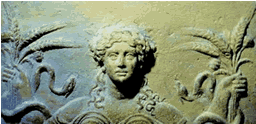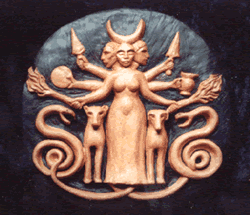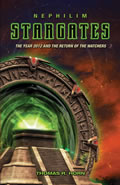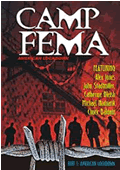PART 5
By Thomas R. Horn
August 27, 2010
NewsWithViews.com
Deeper Truth About Underworld 'Deities'
While
much is still unknown about the mysteries of Demeter, the basis of her
popularity was almost certainly rooted in her divinity as a mother-earth
goddess. Demeter (De or Da "earth", and meter "mother")
actually means "earth mother." The worship of the  earth's
"spirit" as a mother, and the incarnation of the earth's fertility
forces within specific goddesses, was one of the oldest and most widespread
forms of paganism recorded in antiquity. Whether it was Inanna of the
Sumerians, Ishtar of the Babylonians, or Fortuna of the Romans, every
civilization had a sect of religion based on the embodiment of the earth's
spirit as a mother-goddess. The Egyptians worshipped Hathor in this way,
as did the Chinese, Shingmoo. The Germans worshipped Hertha as the great
Mother Earth, and in Greece, the queen of the Olympian goddesses and wife
of Zeus was Hera; the benevolent earth mother. Before her was Gaia (Gaea,
the Greek creator-mother earth) and beneath her were many other Greek
earth spirits, including Demeter, Artemis, Aphrodite, Hecate, and so on.
earth's
"spirit" as a mother, and the incarnation of the earth's fertility
forces within specific goddesses, was one of the oldest and most widespread
forms of paganism recorded in antiquity. Whether it was Inanna of the
Sumerians, Ishtar of the Babylonians, or Fortuna of the Romans, every
civilization had a sect of religion based on the embodiment of the earth's
spirit as a mother-goddess. The Egyptians worshipped Hathor in this way,
as did the Chinese, Shingmoo. The Germans worshipped Hertha as the great
Mother Earth, and in Greece, the queen of the Olympian goddesses and wife
of Zeus was Hera; the benevolent earth mother. Before her was Gaia (Gaea,
the Greek creator-mother earth) and beneath her were many other Greek
earth spirits, including Demeter, Artemis, Aphrodite, Hecate, and so on.
The principle idea was, and evidently still is among New Age devotees, that the earth possesses or is a living entity. The ancient and universally accepted idea that the "living earth" was also a fertile mother was conceptualized in different ways and in various goddess myths and images throughout the ancient world. In The Golden Asse, by second century Roman philosopher Lucius Apuleius, evidence reveals that the spirit of the earth was perceived as a feminine force, and that such force incarnated itself at various times, and to different people, within the goddess mothers. More important, devotion to this deity would have spiritual warfare benefits for binding underworld demons in order to prevent them from passing through gateways and appearing to men. Note how Lucius prays to the earth spirit:
O blessed Queene of Heaven, whether thou be the Dame Ceres [Demeter] which art the original and motherly source of all fruitful things in earth, who after the finding of thy daughter Proserpina [Persephone], through thy great joy which thou diddest presently conceive, madest barraine and unfruitful ground to be plowed and sowne, and now thou inhabitest in the land of Eleusie [Eleusis]; or whether thou be the celestiall Venus....[or] horrible Proserpina...thou hast the power to stoppe and put away the invasion of the hags and ghoasts which appeare unto men, and to keep them downe in the closures [gated cells] of the earth; thou which nourishest all the fruits of the world by thy vigor and force; with whatsoever name is or fashion it is lawful to call upon thee, I pray thee, to end my great travaile... [emphasis added]
The earth spirit responds to Lucius:
Behold Lucius I am come, thy weeping and prayers hath mooved me to succour thee. I am she that is the natural mother of all things, mistresse and governesse of all the elements, the initial progeny of worlds, chiefe of powers divine, Queene of heaven, the principall of the Gods celestiall, the light of the goddesses: at my will the planets of the ayre [air], the wholesome winds of the Seas, and the silence of hell be disposed; my name, my divinity is adored throughout all the world in divers manners, in variable customes and in many names, for the Phrygians call me the mother of the Gods: the Athenians, Minerva: the Cyprians, Venus: the Candians, Diana: the Sicilians, Proserpina: the Eleusians, Ceres: some Juno, other Bellona, other Hecate: and principally the aethiopians...Queene Isis. [2]
One could assume, based on such texts, that a single spiritual source (or realm) energized the many goddess myths. Likewise, in the ancient Hymn, To Earth The Mother Of All, Homer illustrates how the earth-spirit could migrate from its inner-world habitation to become involved in the affairs and lives of nations. Through Homer's dedication to the earth we discover how far-reaching and universal this possibility was thought to be:
I will sing of well founded Earth, mother of all, eldest of all beings. She feeds all creatures that are in the world, all that go upon the goodly land, and all that are in the paths of the seas, and all that fly: all these are fed by her store. Through you, O queen, men are blessed in their children and blessed in their harvests, and to you it belongs to give means of life to mortal men and to take it away. Happy is the man whom you delight to honour! He hath all things abundantly: his fruitful land is laden with corn, his pastures are covered with cattle, and his house is filled with good things. Such men rule orderly in their cities of fair women: great riches and wealth follow them: their sons exult with ever-fresh delight, and their daughters in flower-laden bands play and skip merrily over the soft flowers of the field. Thus it is with those whom you honour O holy goddess, bountiful spirit. Hail, mother of the gods, wife of starry Heaven; freely bestow upon me for this my song substance that cheers the heart! And now I will remember you and another song also. [3]
From these and other ancient records it is obvious that the earth was more than an agricultural or herbaceous facility to the pagans. She was the "eldest of all beings" who manifested herself within the popular idols of the mother goddesses and who could loose or bind the powers held in her underworld.
Like ancient Greeks, Christian theologians affirm that the physical earth contains spiritual forces behind gateways. In the Book of Revelation, chapter nine and verse fourteen, we read of "the four angels which are bound in the great river Euphrates." In Job 26:5, we find "Dead things are formed from under the waters." The literal Hebrew translation says, "The Rafa (fallen angels) are made to writhe from beneath the waters." The belief by Greeks that these beings and regions were under the control of a supernatural "gatekeeper" associated with Hades is both fascinating and enlightening when compared to the previously mentioned words of Christ in Matt. 16.17-18: "Blessed art thou, Simon Barjona [son of Jonah] . . . thou art Peter, and upon this rock I will build my church; and the gates of hell [emphasis added] shall not prevail against it." In the Old Testament, Jonah 2:6 tells of Jonah going down to the bottom of the sea into a "city of gates" (Hebrew B@riyach, a fortress in the earth, a prison) from which God delivered him. There is no doubt about where Jonah was, as he prayed to God out of the belly of hell—the underworld prison of the dead. This unique text in Matthew connecting the rock upon which the Church would be built, the name of Jonah, and the gates of hell is not coincidence.
Christ made the same connection to hell’s gateway, Jonah, and his mission for the Church again in Matt. 12.40: "For as Jonas was three days and three nights in the whale's belly; so shall the Son of man be three days and three nights in the heart of the earth." Additional biblical references indicate the earth is a kind of holding tank, or prison, where God has bound certain fallen entities (2 Pet. 2:4; Jude 6). That such fallen spirits seek to communicate with, or participate in, the affairs of humanity, is defined in Scripture. The Hebrew people were aware that such spirits could seek to move from their habitation into ours ( Deut. 18:11), and when the woman of Endor communicated with the same, they ascended up from "out of the earth" (1 Sam. 28:13). Based on such scriptures, the dynamic or energy behind the earth-goddess-spirits is real, and according to Christian doctrine, identical with the legions of fallen spiritual forces bound within the earth and that seek association with men. Such conclusions can be made because of the obvious and physical location of the biblical demons within the body of the earth and also because of the nature of the manifestations, or attributes, of the goddesses. As previously noted, the myths and rituals behind the earth-goddess-mothers, Demeter, Persephone, and Hecate were openly connected with the evil spirits of the underworld.
When A Demonic Gatekeeper Pretends To Be 'Mother Earth'
Hecate,
the Titan earth-mother of the wizards and witches who helped Demeter after
Hades abducted and raped her daughter  Persephone,
illustrates perhaps better than any other goddess the connection between
the earth goddesses, gateways, and the realm of evil supernaturalism.
As the daughter of Perses and Asteria, Hecate (Hekate) was the only of
the Titans to remain free under Zeus. She was the mother of the wizard,
Circe, and of the witch, Medea, and was considered to be the underworld
sorceress of all that is demonic. This was because Hecate characterized
the unknown night-terrors that roamed the abandoned and desolate highways.
She was often depicted as a young maiden with three faces, each pointing
in a different direction, a role in which she was the earth-spirit that
haunted wherever three paths joined. As the "goddess of three forms"
she was Luna (the moon) in heaven, Diana (Artemis) on earth, and Hecate
in the underworld. At times of evil magic, she appeared with hideous serpents—spreading
demons, encouraging criminal activity, and revealing enigmatic secrets
to the crones. At other times she roamed the night with the souls of the
dead, visible only to dogs, who howled as she approached. When the moon
was covered in darkness, and the hell-hounds accompanied her to the path-beaten
crossways, Hecate came suddenly upon the food offerings and dead bodies
of murders and suicides that had been left for her by the fear-stricken
common-folk. Her hounds bayed, the ghost-torches lit up the night, and
the river nymphs shrieked as she carried away the mangled souls of the
suicides into the underworld caverns of Thanatos (Death), where the shrills
of such damned-ones were known to occupy her presence. In our novel, The
Ahriman Gate, we provided a fictionalized account of Hecate in this
role:
Persephone,
illustrates perhaps better than any other goddess the connection between
the earth goddesses, gateways, and the realm of evil supernaturalism.
As the daughter of Perses and Asteria, Hecate (Hekate) was the only of
the Titans to remain free under Zeus. She was the mother of the wizard,
Circe, and of the witch, Medea, and was considered to be the underworld
sorceress of all that is demonic. This was because Hecate characterized
the unknown night-terrors that roamed the abandoned and desolate highways.
She was often depicted as a young maiden with three faces, each pointing
in a different direction, a role in which she was the earth-spirit that
haunted wherever three paths joined. As the "goddess of three forms"
she was Luna (the moon) in heaven, Diana (Artemis) on earth, and Hecate
in the underworld. At times of evil magic, she appeared with hideous serpents—spreading
demons, encouraging criminal activity, and revealing enigmatic secrets
to the crones. At other times she roamed the night with the souls of the
dead, visible only to dogs, who howled as she approached. When the moon
was covered in darkness, and the hell-hounds accompanied her to the path-beaten
crossways, Hecate came suddenly upon the food offerings and dead bodies
of murders and suicides that had been left for her by the fear-stricken
common-folk. Her hounds bayed, the ghost-torches lit up the night, and
the river nymphs shrieked as she carried away the mangled souls of the
suicides into the underworld caverns of Thanatos (Death), where the shrills
of such damned-ones were known to occupy her presence. In our novel, The
Ahriman Gate, we provided a fictionalized account of Hecate in this
role:
Around the would-be assassins, through the oak boughs, dark shadows began to accumulate. The demon of death, now calling itself Hecate, a black and powerful heathen goddess who enjoyed such fear in antiquity, led countless gleaming torches toward the confused, trembling souls. Horrible snakes wound about her head as hellish dogs and owl-shaped strigae emerged from the gloom and surrounded the killers. The men's eyes darted wildly as their fingers grasped frantically for a weapon. Beneath them, cold, bony fingers cracked through the ground, clasping their corrupted souls, jerking them down in a merciless earthen rend. Their senses, suddenly vivid beyond reason, filled with a burning sensation of sulfur as they burst into unquenchable fire. The mother they had so reverently obeyed during life couldn't and wouldn't help them now. What authority Gaia possessed was against these two anyway. Like Hecate, whose blood red eyes bulged now with murderous delight, Gaia felt only satisfaction as the doomed spirits screamed their way into the eternal torments of Thanatos and Hell. [4]
As the dark goddess of witchcraft, Hecate, like Isis, was worshiped with impure rites and magical incantations. Her name was probably derived from the ancient Egyptian word Heka ("sorcery" or "magical"), which may explain her association with the Egyptian frog goddess of the same name. This may also explain the affiliation of frogs with witchcraft, and the various potions of frog-wart and "hecateis" (Hecate's hallucinogenic plant, also called Aconite), which supposedly sprouted from the spittle of Cerberus (Hade's three-headed guard dog) which fell to the ground when Hercules forced him up to the surface of the earth.
Because her devotees practiced such magic wherever three paths joined, Hecate became known to the Romans as Trivia ( tri "three," and via "roads"). Offerings were also made to her wherever evil or murderous activity occurred, as such areas were believed to be magnets of malevolent spirits, something like "haunted houses," and if one wanted to get along with the resident apparitions they needed to make oblations to the ruler of their darkness—Hecate. The acceptance of the oblations was announced by Hecate's familiar (the night owl), and the spooky sound of the creature was perceived as a good omen by those who gathered on the eve of the full moon. Statues of the goddess bearing the triple-face of a dog, a snake, and a horse, overshadowed the dark rituals when they were performed at the crossing of three roads. At midnight, Hecate's devotees would leave the food offerings at the intersection for the goddess ('Hecate's Supper'), and, once deposited, quickly exit without turning around or looking back. Sometimes the offerings consisted of honey cakes and chicken hearts, while at other times, puppies, honey, and female black lambs were slaughtered for the goddess and her strigae—vicious owl-like affiliates of Hecate who flew through the night feeding on the bodies of unattended babies. During the day the strigae appeared as simple old women, which folklore may account for the history of flying witches. The same strigae hid amidst the leaves of the trees during the annual festival of Hecate (held on August 13), when Hecate’s followers offered up the highest praise of the goddess.
Hecate’s devotees celebrated such festivals near Lake Averna in Campania where the sacred willow groves of the goddess stood, and they communed with the nature spirits and summoned the souls of the dead from the mouths of nearby caves. It was here that Hecate was known as Hecate-Chthonia ("Hecate of the earth"), a depiction in which she most clearly embodied the earth-mother-spirit which conversed through the cave-stones and sacred willow trees. Elsewhere Hecate was known as Hecate-Propolos, "the one who leads," as in the underworld guide of Persephone and of those who inhabit graveyards, and as Hecate-Phosphoros, "the light bearer," her most sacred title and one which recalls another powerful underworld spirit, Satan, whose original name was Lucifer ("the light bearer"). But it was her role as Hecate-Propylaia, "the one before the gate" where true believers most sought out (or feared) her power. In this manifestation, Hecate was believed to not only control entrances at homes and temples to nefarious evils, but spirit-traversing gateways that could be opened by her into the human mind through the use of psychoactive drugs, a practice employed throughout Greek paganism as well as by shamans of other cultures but condemned in the scriptures (Gal. 5:20; Rev. 9:21; 18:23) as pharmakeia—the administering of drugs for sorcery or magical arts in connection with demonic contact.
During research for our new non-fiction book Forbidden Gates, Dr. J. Michael Bennett pointed out in an email that a revival of this ancient practice is currently back in vogue. His comments raise serious questions about the Greek "myths" mentioned above and modern spiritual warfare.
Tom and Nita, the drug known as DMT, which is naturally produced in the pineal gland and is present in wild plants found in places like the Amazon basin has been used for millennia by aboriginal shamans and medicine men to contact the spirit world and to receive information from entities there. It has recently come in "vogue" to experiment with DMT; in fact, "DMT churches" are springing up across America, which center on the ritual intake of the "theurgic" (i.e., psychoactive drug used for ritual purposes) substance to have transcendent contact with spirit intelligences. This chemical is naturally produced by the pineal gland in the brain, which is located behind the forehead. The pineal gland is called the "third eye" by biologists and spiritual teachers, because it has biological elements that are common with the retina of the eye, and in fact are even used as part of parietal sensory organs in other animals. Philosopher and theologian Rene Decartes understood it to be the physical portal to the spirit world, and occult writer H. P. Lovecraft wrote a famous work called "From Beyond" about a portal device that stimulated the human pineal gland in order to make contact with malevolent spirits. A National Geographic journalist wrote about her ingestion of DMT via the traditional Ayahuasca tea delivery means within the Amazon jungle, as part of a sacred circle of fellow participants.
She described falling into an abyss, being summoned by doomed souls who pleaded for release (and she was described as a non-religious person by nature). She then encountered three sinister thrones in an infernal region, and heard threatening voices who told her she could not leave and that there was "no hope." She was "rescued" by her fellow participants, as it is common for adjoining DMT partakers to see the same apparitions, such as serpents enveloping them. Most importantly, psychologist Dr. Rick Strassman conducted a formal clinical study of DMT ingestion under the auspices of the University of New Mexico, which he detailed in his book "DMT: The Spirit Molecule". He found, under controlled clinical conditions, that subjects had these experiences within seconds of ingesting DMT, which almost universally mimicked what are described elsewhere as "alien abduction events" (note that these subjects were screened to be those who were not familiar with stories of UFOs or did not believe in them). The entities they encountered were typically described as traditional "greys", reptilian or insect-like. The contacts usually involved medical and reproductive experiments conducted by the entities on the subjects, described as violent rape episodes. When subjects were willing to try an additional experience, they reported that the entities acknowledged their prior disappearance with no sensation of "time loss." The episodes were so traumatic to the subjects, that a support group was later formed to help them deal with the emotional trauma of the experiences.
I believe the possibility exists that the pineal gland could indeed serve as a means of interacting with the spirit world. According to ancient records, fallen angels taught early humans many things including the use of plants and natural materials in ritual ceremonies for the practice of alchemy and sorcery, and this may include the use of certain wild plants as a source of concentrated DMT to "overload" the neutralizing effects of a chemical in our stomach that under normal circumstances nullifies the effects of DMT. It should also be noted how the Bible mentions the forehead, the region of the pineal gland, in the New Testament book of Revelation in the context of the forces of God or Satan "sealing" their followers there to protect them from the effects of the other. For example, God seals his 144,000 in the forehead and subsequently they are the only ones not subject to dark angelic torment from the beings that exit the Abyss. Conversely, Satan, through the Beast, "seals" the foreheads of his followers with his "mark" and as a result they are forever doomed to his servitude and judgment. Finally, God seals the foreheads of all who enter into the New Jerusalem, with his own name for eternity.
Another theurgic (or at least psycho-active) substance that was used in ancient days that has experienced a modern revival was the alcoholic-based drug "absinthe". This unique, distinctive distilled liquid of pale green color was known in the late nineteenth and early twentieth century as the "green fairy." Although its consumption almost became an obsession across Europe and more mystical cosmopolitan centers in America like New Orleans, it was most closely associated with the bohemian artistic culture thriving at the time. It was a favorite of eclectic artists such as the painter Salvador Dali, and writer Oscar Wilde, due to its reliable propensity to facilitate their contact directly with their inspirational spirit "muses.
| Subscribe to the NewsWithViews Daily News Alerts! |
Occult magician Aleister Crowley was so devoted to absinthe for its spiritual invocation capabilities that he wrote his famous lengthy poem, "The Green Goddess" in its honor. It was the only alcoholic beverage banned across Europe (as well as North America) because the diagnosed "absinthism" addiction and effects were deemed much worse than regular alcohol. The curious matter about absinthe is that it is distilled from the wormwood plant, which has the official name of Artemis absinthium. "Artemis" was a Greek and Roman goddess that was (a) considered a "huntress", (b) associated with fire and keys, and (c) the sister of Apollo. She was associated with the goddess Hecate, who was known as a "luminal" god that controlled the access to portals in the spirit world.
[Editor's note: This series is based on research contained in Tom and Nita Horn's upcoming new book: Forbidden Gates: How Genetics, Robotics, Artificial Intelligence, Synthetic Biology, Nanotechnology, & Human Enhancement Herald the Dawn of Techno-Dimensional Spiritual Warfare.]
Sign up to be notified when the book on which this series is based is released and receive OVER $60.00 IN FREE GIFTS! Sign up here!
Click here for part -----> 1, 2, 3, 4, 5,
� 2010 Thomas Horn - All Rights Reserved
Sign
Up For Free E-Mail Alerts
E-Mails are used strictly for
NWVs alerts, not for sale
Thomas Horn is the CEO of RaidersNewsNetwork.com and SurvivorMall.com.
Over the last decade, he has authored three books, wrote dozens of published editorials, and had several feature magazine articles. In addition to past articles at NewsWithViews.com , his works have been referred to by writers of the LA Times Syndicate, MSNBC, Christianity Today, Coast to Coast, World Net Daily, White House Correspondents and dozens of newsmagazines and press agencies around the globe. Tom's latest book is "The Ahriman Gate," which fictionalizes the use of biotechnology to resurrect Biblical Nephilim.
Thomas is also a well known radio personality who has guest-hosted and appeared on dozens of radio and television shows over the last 30 years, including "The 700 Club" and "Coast to Coast AM." When looking for a spokesperson to promote their film "Deceived" staring Louis Gossett Jr. and Judd Nelson, "Cloud 10 Pictures" selected Thomas as their spokesperson to explain the Christian viewpoint on UFO-related demonology.
Web Site: RaidersNewsNetwork.com
E-Mail: RaidersNewsUpdate@gmail.com














 Share
This Article
Share
This Article







